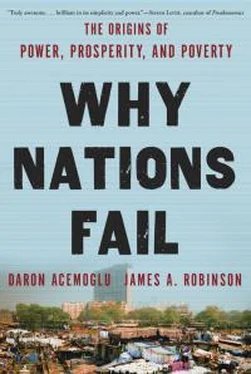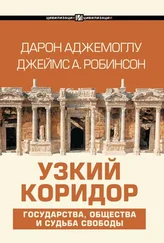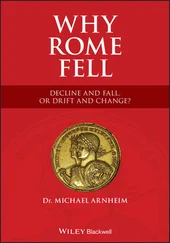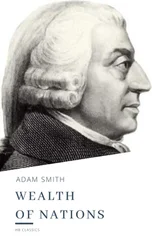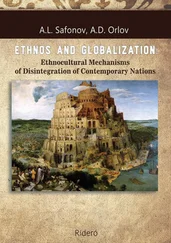By the 1840s, the Ottomans were trying to reform institutions—for example, by reversing tax farming and getting locally autonomous groups under control. But absolutism persisted until the First World War, and reform efforts were thwarted by the usual fear of creative destruction and the anxiety among elite groups that they would lose economically or politically. While Ottoman reformers talked of introducing private property rights to land in order to increase agricultural productivity, the status quo persisted because of the desire for political control and taxation. Ottoman colonization was followed by European colonization after 1918. When European control ended, the same dynamics we have seen in sub-Saharan Africa took hold, with extractive colonial institutions taken over by independent elites. In some cases, such as the monarchy of Jordan, these elites were direct creations of the colonial powers, but this, too, happened frequently in Africa, as we will see. Middle Eastern countries without oil today have income levels similar to poor Latin American nations. They did not suffer from such immiserizing forces as the slave trade, and they benefited for a longer period from flows of technology from Europe. In the Middle Ages, the Middle East itself was also a relatively advanced part of the world economically. So today it is not as poor as Africa, but the majority of its people still live in poverty.
WE HAVE SEEN that neither geographic- nor cultural- nor ignorance-based theories are helpful for explaining the lay of the land around us. They do not provide a satisfactory account for the prominent patterns of world inequality: the fact that the process of economic divergence started with the Industrial Revolution in England during the eighteenth and nineteenth centuries and then spread to Western Europe and to European settler colonies; the persistent divergence between different parts of the Americas; the poverty of Africa or the Middle East; the divergence between Eastern and Western Europe; and the transitions from stagnation to growth and the sometimes abrupt end to growth spurts. Our institutional theory does.
In the remaining chapters, we will discuss in greater detail how this institutional theory works and illustrate the wide range of phenomena it can account for. These range from the origins of the Neolithic Revolution to the collapse of several civilizations, either because of the intrinsic limits to growth under extractive institutions or because of limited steps toward inclusiveness being reversed.
We will see how and why decisive steps toward inclusive political institutions were taken during the Glorious Revolution in England. We will look more specifically at the following:
• How inclusive institutions emerged from the interplay of the critical juncture created by Atlantic trade and the nature of preexisting English institutions.
• How these institutions persisted and became strengthened to lay the foundations for the Industrial Revolution, thanks in part to the virtuous circle and in part to fortunate turns of contingency.
• How many regimes reigning over absolutist and extractive institutions steadfastly resisted the spread of new technologies unleashed by the Industrial Revolution.
• How Europeans themselves stamped out the possibility of economic growth in many parts of the world that they conquered.
• How the vicious circle and the iron law of oligarchy have created a powerful tendency for extractive institutions to persist, and thus the lands where the Industrial Revolution originally did not spread remain relatively poor.
• Why the Industrial Revolution and other new technologies have not spread and are unlikely to spread to places around the world today where a minimum degree of centralization of the state hasn’t been achieved.
Our discussion will also show that certain areas that managed to transform institutions in a more inclusive direction, such as France or Japan, or that prevented the establishment of extractive institutions, such as the United States or Australia, were more receptive to the spread of the Industrial Revolution and pulled ahead of the rest. As in England, this was not always a smooth process, and along the way, many challenges to inclusive institutions were overcome, sometimes because of the dynamics of the virtuous circle, sometimes thanks to the contingent path of history.
Finally, we will also discuss how the failure of nations today is heavily influenced by their institutional histories, how much policy advice is informed by incorrect hypotheses and is potentially misleading, and how nations are still able to seize critical junctures and break the mold to reform their institutions and embark upon a path to greater prosperity.
5.
“I’VE SEEN THE FUTURE, AND IT WORKS”: GROWTH UNDER EXTRACTIVE INSTITUTIONS
I’VE SEEN THE FUTURE
INSTITUTIONAL DIFFERENCES PLAY the critical role in explaining economic growth throughout the ages. But if most societies in history are based on extractive political and economic institutions, does this imply that growth never takes place? Obviously not. Extractive institutions, by their very logic, must create wealth so that it can be extracted. A ruler monopolizing political power and in control of a centralized state can introduce some degree of law and order and a system of rules, and stimulate economic activity.
But growth under extractive institutions differs in nature from growth brought forth by inclusive institutions. Most important, it will be not sustained growth that requires technological change, but rather growth based on existing technologies. The economic trajectory of the Soviet Union provides a vivid illustration of how the authority and incentives provided by the state can spearhead rapid economic growth under extractive institutions and how this type of growth ultimately comes to an end and collapses.
THE FIRST WORLD WAR had ended and the victorious and the vanquished powers met in the great palace of Versailles, outside Paris, to decide on the parameters of the peace. Prominent among the attendees was Woodrow Wilson, president of the United States. Noticeable by its absence was any representation from Russia. The old tsarist regime had been overthrown by the Bolsheviks in October 1917. A civil war then raged between the Reds (the Bolsheviks) and the Whites. The English, French, and Americans sent an expeditionary force to fight against the Bolsheviks. A mission led by a young diplomat, William Bullitt, and the veteran intellectual and journalist Lincoln Steffens was sent to Moscow to meet with Lenin to try to understand the intentions of the Bolsheviks and how to come to terms with them. Steffens had made his name as an iconoclast, a muckraker journalist who had persistently denounced the evils of capitalism in the United States. He had been in Russia at the time of the revolution. His presence was intended to make the mission look credible and not too hostile. The mission returned with the outlines of an offer from Lenin about what it would take for peace with the newly created Soviet Union. Steffens was bowled over by what he saw as the great potential of the Soviet regime.
“Soviet Russia,” he recalled in his 1931 autobiography, “was a revolutionary government with an evolutionary plan. Their plan was not to end evils such as poverty and riches, graft, privilege, tyranny, and war by direct action, but to seek out and remove their causes. They had set up a dictatorship, supported by a small, trained minority, to make and maintain for a few generations a scientific rearrangement of economic forces which would result in economic democracy first and political democracy last.”
When Steffens returned from his diplomatic mission he went to see his old friend the sculptor Jo Davidson and found him making a portrait bust of the wealthy financier Bernard Baruch. “So you’ve been over in Russia,” Baruch remarked. Steffens answered, “I have been over into the future, and it works.” He would perfect this adage into a form that went down in history: “I’ve seen the future, and it works.”
Читать дальше
